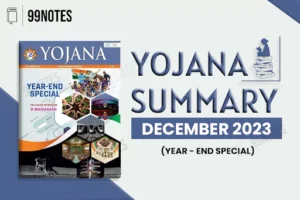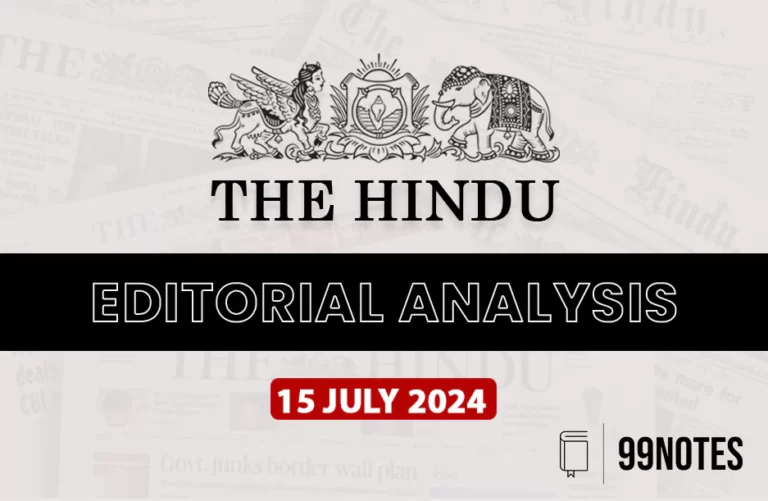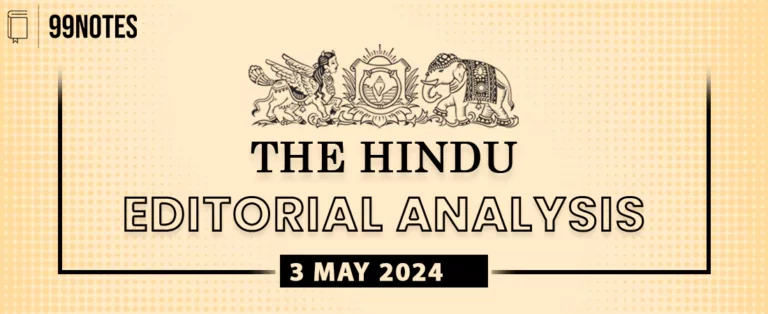15 February 2024 : The Hindu Editorial Notes PDF
The Hindu Editorial
15-February-2024
1. A demand that could hamper gender equality
| Topic: GS2 – Social Justice – Vulnerable sections UPSC candidates must comprehend gender issues, discrimination, and policy implications for a nuanced understanding of societal challenges and reforms. |
| Context |
|
Sabrimala Temple Issue: Menstruation and Discrimination
- Background: The Sabrimala temple controversy brought attention to the discrimination against menstruating women, challenging traditional beliefs.
- Gender Equality: The struggle aims to eliminate discriminatory practices related to menstruation and promote gender equality.
Paid Menstrual Leave: A Counterproductive Move?
- Challenges of Menstrual Cycles: While acknowledging the challenges of menstrual cycles, labelling all women for paid leave may trivialize the women empowerment movement.
- Global Gender Gap: The World Economic Forum’s 2021 report indicates a widening gender gap, with 84 cents earned by women for every dollar earned by men.
Concerns Regarding Special Status for Menstruating Women
- Social Stigma: Granting special status may validate social stigma around menstruation, exacerbating period shaming in a country where it is considered ‘impure.’
- NFHS Report: The recent National Family Health Survey highlights the prevalent use of cloth for menstrual protection, leading to health risks due to insufficient awareness and societal taboos.
Japan’s Experience: Unintended Consequences
- Japanese Policy: Japan provides leave for painful menstruation, but it is mostly unpaid and unused, contributing to workplace disparities and gender inequality.
- Enforcement Challenges: Implementing paid leave raises concerns about misuse and acceptable enforcement methods, as seen in incidents of forced checks in educational institutions in India.
On-going Struggles for Women’s Rights
- Combat Roles: Women’s fight for equal evaluation and roles in ground combat continues, highlighting on-going gender disparities.
- Corporate Equality: Women in corporate organizations are advocating for equal pay, emphasizing the need for gender parity.
Recognizing Diverse Experiences
- Individualized Support: Acknowledging the diverse nature of menstrual experiences is crucial, advocating for inclusive and case-by-case support rather than blanket policies.
Conclusion:
- In conclusion, while addressing menstrual challenges is essential, blanket policies such as mandatory paid leave risk unintended consequences.
- Advocating inclusivity and case-specific support ensures a nuanced approach to menstrual issues, fostering genuine gender equality.
| PYQ: Explain the constitutional perspectives of Gender Justice with the help of relevant Constitutional Provisions and case laws. (250 words/15m) (UPSC CSE (M) GS-2 2023) |
| Practice Question: How do the Sabrimala temple issue and the debate on paid menstrual leave reflect broader challenges in achieving gender equality in India? Discuss. (150 words/10 m) |
2. Rescuing grace from disgrace
| Topic: GS2 – Indian Polity – Executive Critical for UPSC: Understanding ceremonial addresses’ controversies and proposed reforms provides insight into Indian political traditions and governance challenges. |
| Context |
|
Introduction:
- The addresses of the President of India and Governors to Parliament and Legislative Assemblies respectively are described as ‘customary,’ ‘ceremonial,’ and ‘ritualistic.’
- These events, deeply embedded in Indian political culture, involve elaborate ceremonies and speeches.
- The tradition of these addresses follows British practice, with the speeches drafted by the government of the day.
Presidential Engagement:
- Venkataraman, President from 1987 to 1992, actively reviewed and modified the draft speeches received from the government.
- He suggested a reform inspired by the concise nature of the British Throne Speech, aiming to save time and reduce tension during the opening ceremonies.
Presidential Involvement:
- President K.R. Narayanan (1997-2002) exhibited meticulous attention to detail, with changes suggested by him being universally acknowledged for their pertinence and propriety.
Governor’s Role And notable instances:
- As the Governor of West Bengal, the author (Gopal Krishna Gandhi) suggested changes to draft addresses, and Chief Minister Buddhadeb Bhattacharjee readily accepted them, even resorting to last-minute corrections for oversight.
- As an officiating Governor of Bihar, the author (Gopal Krishna Gandhi) delivered a flawless speech without interruptions, earning praise from Chief Minister Nitish Kumar.
Controversies and Challenges:
- The article highlights the rising frequency and intensity of controversies over Governors’ addresses in Legislative Assemblies.
- The root cause is identified as the dichotomy between the agency writing the speech and the one delivering it.
Proposed Solution:
- The author suggests a solution inspired by President Venkataraman’s idea, proposing that the Head of State only delivers a brief outline of legislative business, leaving the detailed addresses to the Motion of Thanks that follows, similar to British Parliament.
Challenges for Reform:
- The article acknowledges the potential reluctance of governments to forego the opportunity to showcase their accomplishments and plans during the opening ceremonies.
- The need for innovative and self-denying Chief Ministers to initiate reforms is emphasized to rescue the tradition of these addresses from increasing controversies and tensions.
Conclusion:
- In conclusion, the article underscores the urgency for innovative Chief Ministers to initiate reforms in the ceremonial addresses of Presidents and Governors, highlighting the need to rescue these traditions from escalating controversies and tensions.
| Tussel between Governor – State Executive |
Reasons:
Implications:
Way Forward:
|
| PYQ: Whether the Supreme Court Judgement (July 2018) can Settle the political tussle between the Lt. Governor and elected government of Delhi? Examine. (250 words/15m) (UPSC CSE (M) GS-2 2018) |
| Practice Question: Examine the recent instances of friction between Governors and State Executives in India. Analyze the key reasons and potential consequences of such clashes. Suggest measures to ensure harmonious cooperation within the framework of cooperative federalism (150 words/10 m) |
For Enquiry

15 February 2024 : The Hindu Editorial Notes PDF

15 February 2024 : PIB Summary for UPSC

UPSC CSE 2024 Notification

14 Feb 2024 : Daily Current Affairs Quiz

14 Feb 2024 : Daily Answer Writing

14 February 2024 : The Hindu Editorial Notes PDF

14 Feb 2024 : Daily Current Affairs

14 Feb 2024 : Indian Express Editorial Analysis

14 February 2024 : PIB Summary for UPSC

Yojana Magazine Summary December 2023: Year End Special
Feb 2024 The Hindu 15 February 2024 : The Hindu Editorial Notes PDF The Hindu Editorial
15-February-2024
1. A demand that could hamper gender equality
Topic: GS2 –…
feb 2024 PIB 15 February 2024 : PIB Summary for UPSC PIB Summary for UPSC
15-February -2024
1. 16th Finance Commission holds first meeting under Chairmanship…
Blogs Upsc UPSC CSE 2024 Notification UPSC CSE 2024 Notification
14-Feb-2024
UPSC Notification 2024 PDF
UPSC CSE 2024 Notification: –
Examination…
Daily Quiz 14 Feb 2024 : Daily Current Affairs Quiz 14 Feb 2024 : Daily Quiz…
mains answer writing 14 Feb 2024 : Daily Answer Writing Mains Answer Writing
14-February-2024
Q1) Explain the primary lines of evidence supporting the theory…
Feb 2024 The Hindu 14 February 2024 : The Hindu Editorial Notes PDF The Hindu Editorial
14-February-2024
1. Old-fashioned trust and credibility bind India-UAE ties.
Topic:…
Daily Current Affairs 14 Feb 2024 : Daily Current Affairs Daily Current Affairs
14-February-2024- Top News of the Day
1. Farmers Demand Legal Guarantee for MSP…
Indian Express 14 Feb 2024 : Indian Express Editorial Analysis Indian Express Editorial Analysis
14-February-2024
1. An Arabian Valentine
Topic: GS2 – International…
feb 2024 PIB 14 February 2024 : PIB Summary for UPSC PIB Summary for UPSC
14-February -2024
1. A new method for sodium catalyzed synthesis of carbon nanotubes…
Yojana Summary Yojana Magazine Summary December 2023: Year End Special Yojana Magazine Summary December 2023
Yojana magazine is monthly magazine published by government of…




